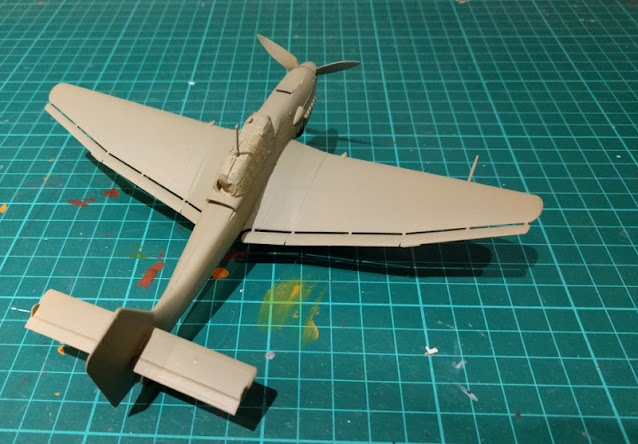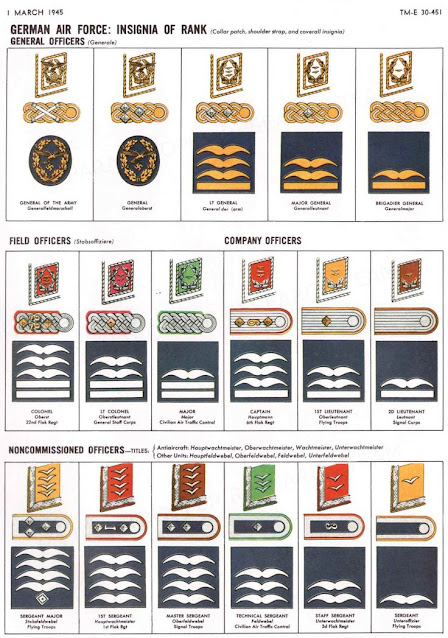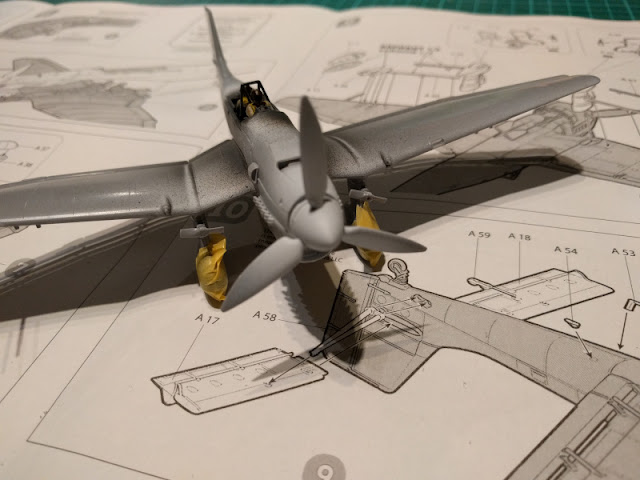Some brush painting
Canopy
After the paint had cured on the canopy I somewhat anxiously tore off the masking tapes. The result was, as I guess was somehow predictable, suboptimal. There were some white primer overflows here and there, which I scratched off to the best of my abilities with the tip of an hobby knife. For some covering up I did a bit of fine-tip painting over the nonsense, where I needed to. It was somehow tolerable from a distance, after all.
Now plese remind me, why I'm not primarily an airplane guy, hm?
Now plese remind me, why I'm not primarily an airplane guy, hm?
Details matter
The propeller blades I painted almost black (VMA 71055 Black Grey RLM66) and the bottom half of the spinner that had turned blue I returned back to the yellow-brown world. While pondering on the bombs my searches took me via the FSM forums to some odd and unexpected sites (http://www.warbirdsresourcegroup.org/LRG/bombs.html), where the Luftwaffe's bombs and their variants were described very nicely. It was a very handy link, now if I only managed to remember it in the distant future!
In this case the bomb pairs slung under the wings were model SC 50 Bi (reason for this choice: the colour) and the underbelly bomb was an SC 500 Grade III (the only one listed, no need to choose). With this in mind I painted the little bombs dark grey and left the main one blue, I just touched it up a bit here and there. The big one then needed a yellow stripe in each sector of the butt-end, between the winglets. So that's why I did (VMA 71002 Medium Yellow), it just didn't stand out too well out of a sky-blue bomb.
In this case the bomb pairs slung under the wings were model SC 50 Bi (reason for this choice: the colour) and the underbelly bomb was an SC 500 Grade III (the only one listed, no need to choose). With this in mind I painted the little bombs dark grey and left the main one blue, I just touched it up a bit here and there. The big one then needed a yellow stripe in each sector of the butt-end, between the winglets. So that's why I did (VMA 71002 Medium Yellow), it just didn't stand out too well out of a sky-blue bomb.
Fixing this and that
At this point I realized - while duckducking colour photos of the propellers of the jericho sirens - that I should've painted them sand-coloured, or to be more exact: I shouldn't have painted them blue in the first place. Learning is good, they say. I decided to fix them by hand and I think I saved at least half an hour of masking time, not to mention the time I could potentially have spent fixing any overspray.By my gut feeling I masked off an area for the white theatre band. These have never worked the way I have wanted, but as I haven't found a better, more reliable way, this has been my method. I did the band and the tip of the spinner with white paint. To avoid the overflow, just like with the landing gear, I left the airbrush at the dock. And to make my life that much simpler.
While I was on a roll I also painted the radio operator's MG's barrel and handleable bits along with all three wheels completely black. I thought that in this case the contrast difference would be strong enough and this way they could maybe be distinguished from the dark grey bombs. Maybe I should go again to look for the rubber-coloured paint, just so I could at least once say that I have done wheels "correctly".



























